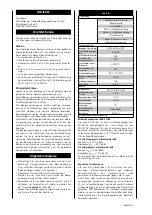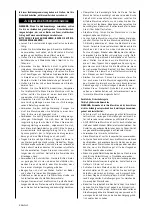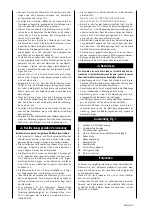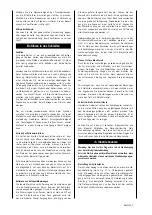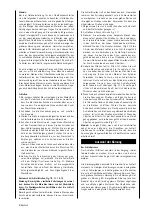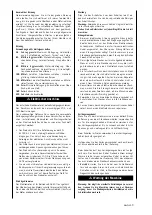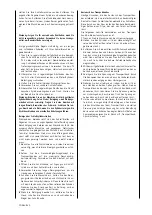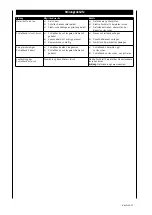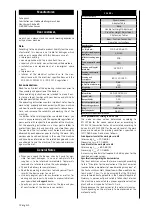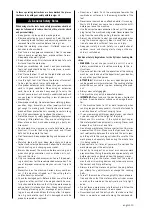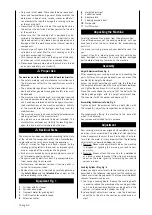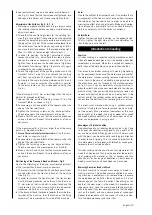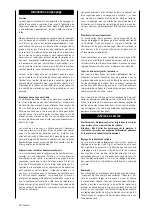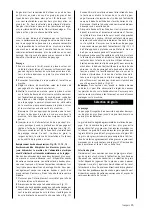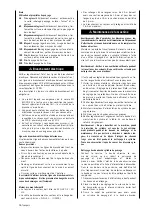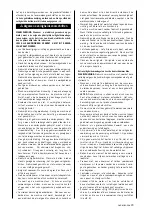
14 english
• Only sand intact wood. There should be no loose knot-
holes and few knotholes in general. Make sure that the
work piece is free of nails, screws, stones or other al-
ien elements that could damage the sanding cylinder
or the sanding belt.
• Never stand in the direct line of the sanding band, on
the entry or the exit side. Position yourself to the side
of the machine.
• Make sure that the sanding belt is positioned as de-
scribed in the operating instructions. A belt that is not
tightened correctly may loosen during operation and
damage either the work piece or the internal machine
components.
• Never put your fingers into the dust exit or under the
cylinder‘s dust cover. Wait to start sanding until the
cylinder has reached full speed.
• Turn the machine off, and pull the plug out of the sock-
et, when you install accessories or remove them.
• Never leave the work area, when the machine is turned
on or not completely at a standstill.
m
Proper Use
The machine meets the currently valid EU machine directive.
• The safety, working, and maintenance instructions and
the dimensions set forth in the specifications must be
observed.
• The applicable regulations for the prevention of acci-
dents and other, generally recognized safety rules must
be observed.
• The machine may only be used, maintained or repaired
by trained persons who are familiar with the machine
and have been informed about the dangers. Unauthor-
ized modifications of the machine exclude a liability
of the manufacturer for damages resulting from the
modifications.
• The machine may only be used with original accessories
and original tools of the manufacturer.
• Any other use is considered to be not intended. The
manufacturer excludes any liability for resulting dam-
ages, the risk is exclusively borne by the user.
m
Residual Risks
The machine has been constructed according to the state
of the art and the recognized safety rules. Nevertheless,
single residual risks may occur during the operation.
• Risk of injuries for fingers and hands caused by the
rotating grinding roller in the case of an improper guid-
ance or support of the work piece to be ground.
• Risk of injury caused by hurling work pieces in case of
an improper support or guidance.
• Danger caused by electric current if inappropriate elec-
trical connecting lines are used.
• Furthermore, non obvious residual risks may exist in
spite of all measures taken.
• Residual risks can be minimized by carefully observing
the
Safety Notes and the Intended Use as well as the
entire operating instructions.
Equipment Fig. 1
1 Cylinder with dust cover
2 Cylinder drive motor
3 Transport motor for grinding belt
4 On/Off switch for variable speed
5 Extension tables
6 Height adjustment
7 Extraction nozzle
8 Adapter plate
9 Feeding transport belt
10 Guide skid
11 On/Off switch
Unpacking the Machine
Carefully remove all the pieces from the delivery carton.
Do not throw away any of the packing materials, until you
have found all of the parts listed on the accompanying
parts list.
If a piece is missing, please ask your dealer to send it to
you.
Inspect all parts in order to make sure that nothing has
been damaged in transport. You must replace damaged
parts before attempting to work with the machine.
Assembly
Height Adjustment Crank Fig. 2
After unpacking your sanding machine and checking the
parts list for any missing components, you can mount the
handle (B) for height adjustment.
Screw the height adjustment handle into the thread on
the height adjustment crank (A). Use a slotted screwdriver
and tighten the handle until it is firmly fixed in place.
Place the crank above the axle, so that the bolt with the
latching wedge aligns with the height adjustment axle.
Then secure it with the washer and dome nut (C).
Assembling the Extension Table, Fig. 3
Tighten by hand the extension table, on both sides, with
the screws (D), adjust the transport band and tighten it.
We recommend affixing the machine to the base with
which it is delivered.
Four screws are included for this purpose.
Adjustment
Your sanding machine was aligned and completely adjust-
ed when it was assembled. The effects of transport may
make it necessary to adjust the unit or to align it, or to re-
turn it for this work. It is very important that the following
adjustments, as described below, be made.
• Warning: Never make adjustments when the machine
is plugged in. Ignoring this warning can lead to seri-
ous injury.
• Warning: Always attach the machine to a workbench
or a base, in order to prevent it from tipping or moving
about on the table. Ignoring this warning can lead to
serious injuries.
Sanding Cylinder Play, Fig. 4
Before you begin adjustments to the sanding cylinder, as
described in the following, make sure that the sanding cyl-
inder has minimal play upwards. The three most important
reasons for excessive play are:
1 Too large a sanding depth. Reduce the sanding depth
in order to reduce the pressure on the sanding cylinder
unit. See the directions about the sanding depth in the
section „Introduction to Cylinder Sanding“.
2 Loose height adjustment screws -- see the directions
about the cut depth in the section on cylinder adjust-
ment.



